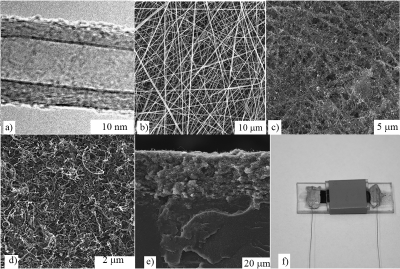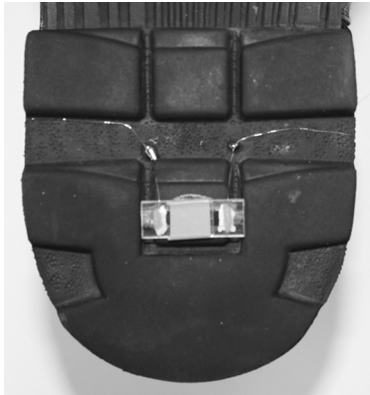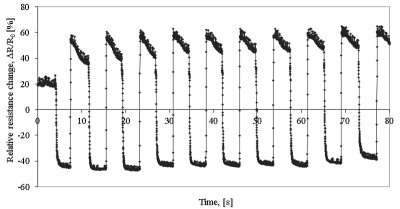Pressure sensitive polyurethane/carbon nanotube laminate pasted to a shoe sole
12. Október, 2015, Autor článku: Slobodian Petr, Elektrotechnika
Ročník 8, číslo 10  Pridať príspevok
Pridať príspevok
![]() A thermoplastic polyurethane (TPU)/carbon nanotube (CNT) network laminate was prepared by innovative method when a non-woven TPU membrane made by electro-spinning process was used as filtering mesh for CNT aqueous dispersion. Finally this semi-product was integrated by compression molding with TPU base and TPU covering. Prepared element is electrically conductive composite laminate material with favorable properties as electro-mechanical signal transducer capable to detect applied compression stress when its application leads to decrease in its macroscopic electrical resistance. A sensing element was used for measurements of the pressure between the shoe and floor during marching. The results recorded as sensor resistance change show reasonable reversibility of the basic sensor characteristics, which gives potential for its practical applications.
A thermoplastic polyurethane (TPU)/carbon nanotube (CNT) network laminate was prepared by innovative method when a non-woven TPU membrane made by electro-spinning process was used as filtering mesh for CNT aqueous dispersion. Finally this semi-product was integrated by compression molding with TPU base and TPU covering. Prepared element is electrically conductive composite laminate material with favorable properties as electro-mechanical signal transducer capable to detect applied compression stress when its application leads to decrease in its macroscopic electrical resistance. A sensing element was used for measurements of the pressure between the shoe and floor during marching. The results recorded as sensor resistance change show reasonable reversibility of the basic sensor characteristics, which gives potential for its practical applications.
Introduction
The area of carbon based nano-allotropes like carbon nanotubes has been intensively in the centre of scientists’ attention but its potential has not yet been exhausted. It was for example demonstrated that they can be practically used in the field of sensing technology as a novel types of polymeric matrixes/CNT nanocomposites sensors [1-3]. Such electro-mechanical signal transducers can be in form of electrically conductive matrixes filed particular filler as bulk polymer nanocomposite [2,3] or as a laminates where layer of interconnected CNT of Buckypaper (CNT entangled network) is integrated into polymeric base [1,4-7].
In the case of the entangled network, the resistance response to deformation is governed by nanotube interactions. The decisive role is played by local resistance in nanotube contacts and the straightening and buckling of nanotubes what affects the number of contacts between nanotubes. In the case of applied compression stress the number of contacts increases leading to macroscopic resistance decrease. Such interconnected CNT structures can detect stress or deformation with enough sensitivity, reversibility and in real time of stress application. The objective of our paper is to explore properties of a pressure sensing element made of conductive composite consisting of entangled network of multi-walled carbon nanotubes (MWCNT) embedded in TPU. The composite sensor was tested for footwear evaluation.
Experimental
Purified MWCNT produced by acetylene chemical vapor deposition were supplied by Sun Nanotech Co. Ltd., China. According to the supplier, the nanotube diameter is 10-30 nm, length 1-10 μm, purity >90% and volume resistivity 0.12 Ωcm. The thermoplastic polyurethane elastomer Desmopan DP 2590A was supplied by Bayer MaterialScience. The ultimate strength of 48.9 MPa, with a strain at break 4.422 and a density of 1.205 g/cm3 were specified by supplier. The adequate PU compression molding temperature was selected to be 175°C, according DSC measurement (Perkin-Elmer Pyris 1) performed at a heating rate of 10°C/min.
The nanotubes were used for the preparation of aqueous paste: 1.6 g of MWCNT and ∼50 ml of deionized water were mixed with the help of a mortar and pestle. The paste was then diluted in deionized water with sodium dodecyl sulfate (SDS) and 1-pentanol as surfactants. Consequently, NaOH aqueous solution was added to adjust pH to the value of 10. The final nanotube concentration in the suspension was 0.3 wt.%, concentrations of SDS and 1-pentanol were 0.1M and 0.14M, respectively. The suspension was sonicated in using sonication horn UZ Sonopuls HD 2070 kit for 15 minutes. To make an entangled MWCNT network on a polyurethane porous membrane [8], a vacuum filtration method was used. The conditions of electrospinning were as follows: a PU weight concentration of 16 wt%, the solution electrical conductivity adjusted to 20 μS/cm using sodium chloride, an electric voltage of 75 kV (Matsusada DC power supply), a temperature of 20-25°C, and a relative humidity of 25-35 %. The membrane was prepared in cooperation with the company SPUR a.s, of Czech Republic. The formed disk-shaped network was washed several times with deionized water and methanol in situ.
MWCNT network/PU composite was melt welded onto the surface of TPU strip and covered by TPU coverage by the same method. In the former case, Such MWCNT network/PU laminate was pasted to a shoe sole. The electrical contacts were fixed to the strip by a silver-colloid electro-conductive paint Dotite D-550 (SPI Supplies) and the resistance was measured lengthwise by the two-point technique using multimeter Sefram 7338. The time-dependent resistance change was monitored through the Vernier LabQuest Interface System connected to the Differential Voltage Probe and the Wheatstone bridge with sampling frequency 100 Hz.
Results and discussion
TEM analyses of nanotube structure of used multi-walled carbon nanotubes (MWCNT) performed with help of JEOL JEM 2010 are presented in Fig. 1 part a). As can be seen, the nanotube consists of about 15 rolled layers of graphene, with the interlayer diameter of ca 0.35 nm. The structure of PU non-woven filtering membrane, prepared by the electro-spinning process, is shown as scanning electron microscope picture (SEM – Vega LMU Tescan s.r.o., Czech Republic), see Fig. 1 part b). The initial state of CNT filtration is shown in Fig. 1 part c). SEM micrograph of the surface of entangled MWCNT network is presented in Fig. 1 part d). The partial infiltration of MWCNTs into the filter pores creates an effective interlocking of MWCNT network layer with PU filter which even strengthens when the porous filter is transformed into the polymeric film.
The composite cross-section after the compression moulding is shown in Fig. 1 part e). The interaction between MWCNTs and the porous filter is mechanical before the compression moulding. Moreover, the melted polymer apparently encloses MWCNTs from MWCNT network surface in the course of moulding at 175 °C, making firm connection between the polymer and layer of entangled nanoparticles. A picture demonstrating final pressure sensor which will be pasted to a shoe sole constructed as trip of MWCNT/TPU composite covered by TPU is presented in Fig. 1 part f).

Fig. 1 a) TEM analyses of nanotube structure of used multi-walled carbon nanotubes (MWCNT) (JEOL JEM 2010), b) SEM micrograph of polyurethane non-woven filtering membrane, c) polyurethane non-woven filtering membrane at initial part of CNT aqueous dispersion filtration with entrapped carbon nanotubes, d) SEM micrograph of the surface of entangled MWCNT network, e) SEM analyses demonstrating the transformation of TPU non-woven filtrating membrane into form of TPU thin film with interlocked carbon nanotubes network, f) Strip of MWCNT/TPU composite covered by TPU coverage as a pressure sensor.
To illustrate a potential practical use of the produced electrically conductive composite, plantar pressure detection was investigated. To test the sensing abilities of the composite, we measured the pressure between the shoe sole and the floor during a volunteer’s marching on the spot. A photograph of the shoe sole with fixed pressure sensor is presented in Fig. 2.

Fig. 2 MWCNT/TPU composite pressure sensor pasted to a shoe sole.
Response onto applied mechanical stress were measured as time-dependent electrical resistance changes further converted onto percentage of relative resistance change defined as:
| (1) |
where R0 is the electrical resistance of the measured sample before the first elongation, and R is the resistance while elongating. The waveforms recorded in terms of relative resistance are shown in Fig. 3.

Fig. 3 Waveforms of the relative resistance during volunteer’s marching detected by MWCNT/PU sensor adhered to the shoe sole (solid symbols), showing the composite sensor repetitive properties.
The resistance of the sensors sensitively response onto applied pressure during volunteer’s marching. The response is reversible in many cycles, see Fig. 3 As can be seen in the figure, the sensor´s resistance is reproducible and no material property variation is observed. As a commercial sensor made of MWCNT/PU composite should withstand multiple test cycles, we believe that our composite has reasonable durability and reversibility of basic characteristics and is able to comply with practical application requirements. Moreover, during the volunteer’s exercise, no obstructions or difficulties were subjectively noticed, which shows that the system is flexible enough to be used, for instance, for monitoring the human body movements.
Conclusion
In the paper we have introduced polymeric composite laminate consisting of TPU with layer made of CNT capable to detect compression stress. Functional layer created by a network of electrically conductive CNT is prepared by innovative procedure using entangled carbon nanotubes non-woven polyurethane filtering membrane in which carbon nanotubes were enmeshed and melt integrated. As an example of the composite reliable application as a stress sensor plantar pressure during marching on the spot was measured. The results in terms of sensor resistance change are promising for real application of described solution.
Acknowledgement
This project was supported by the by the National Budget of the Czech Republic within the framework of the Centre of Polymer Systems project (reg. no.: CZ.1.05/2.1.00/03.0111). This project was also supported by the internal grant of TBU in Zlin No. IGA/CPS/2015/001 funded from the resources of the Specific University Research.
References
- Slobodian P., Riha P., Olejnik R. Electromechanical sensors based on carbon nanotube networks and their polymer composites. In: Mukhopadhyay SC, Lay-Ekuakille A, Fuchs A, editors. New Developments and Applications in Sensing Technology, Springer Verlag, 2011, p. 233-251.
- De la Vega A., Kinloch I.A., Young R.J., Bauhofer W. Simultaneous global and local strain sensing in SWCNT-epoxy composites by Raman and impedance spectroscopy. Compos Sci Technol 2011;71:160-166.
- Bilotti E., Zhang R., Deng H., Baxendale M., Peijs T. Fabrication and property prediction of conductive and strain sensing TPU/CNT nanocomposite fibres. J Mat Chem 2010;20:9449-9455.
- Thostenson E.T., Chou T.W. Real-time in situ sensing of damage evolution in advanced fiber composites using carbon nanotube networks. Nanotechnology 2008;19:article no. 215713.
- Kang I.P., Schulz M.J., Kim J.H., Shanov V., Shi D.L. A carbon nanotube strain sensor for structural health monitoring. Smart Mater Struct 2006;15:737-748.
- Slobodian P., Riha P., Lengalova A., Saha P. Compressive stress-electrical conductivity characteristics of multiwall carbon nanotube networks. J Mater Sci 2011;46:3186-3190.
- Slobodian P., Riha P., Lengalova A., Olejnik R., Saha P. Effect of compressive strain on electric resistance of multi-wall carbon nanotube networks. J Exp Nanosci 2011;6:294-304.
- Kimmer D., Slobodian P., Petras D., Zatloukal M., Olejník R., Saha P. Polyurethane/Multiwalled Carbon Nanotube Nanowebs Prepared by an Electrospinning Process. J. Appl. Polym. Sci. Vol. 111 (2009), p. 2711.
Co authors of this paper are Michal Kovar, Robert Olejnik, Jiri Matyas; Centre of Polymer Systems, University Institute, Tomas Bata University, Trida T. Bati 5678, Zlin, Czech Republic and Polymer Centre, Faculty of Technology, Tomas Bata University, TGM 275, Zlin, Czech Republic

